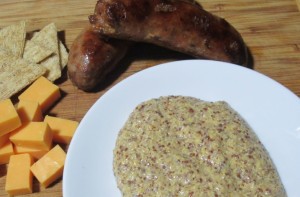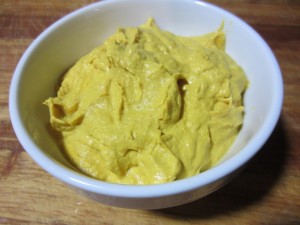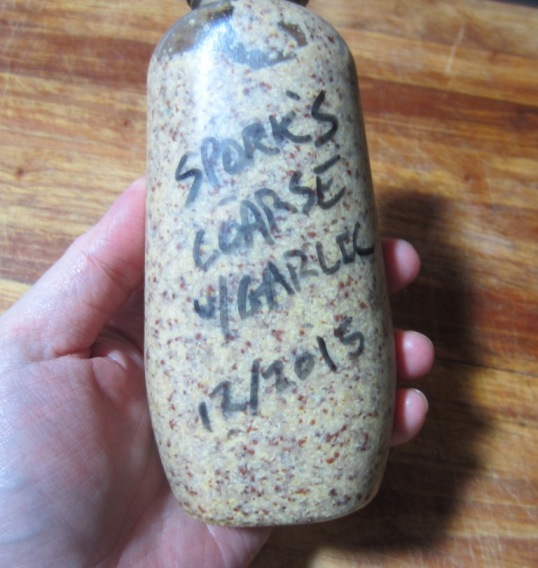Making mustard is as easy as falling off a sandwich. Mustard seeds, water, salt, and vinegar combined with a good blender and bit of time to mature in the fridge and it’s job done. The finesse is in the details. Let me explain several versions and show you how to make them all in mere minutes with a few simple steps at home. It will take you longer to clean the blender than it does to make your very own palate of unique mustards to accompany everything from cheese plates to sausage-in-a-bun.
Here in Canada, winter keeps us from being great lemon or avocado farmers but we’re really good at a few specific crops that don’t mind the fact that we can still have snow on the ground many places in late May. Wheat, maple, and lobster come to most people’s minds pretty easily but we’re also top of the heap in world mustard seed production. All that empty space on the plains of Manitoba and Saskatchewan I drove across a few years back is great for making seed crops and mustard is a popular and easy planting so our farmers are on the Brassica bandwagon in full force. We crank out over a hundred and fifty thousand tonnes of the stuff annually dwarfing nearly all global competitors although several countries south of the Himalayas (Nepal, Burma, et. al.) post some respectable production numbers too. It’s a climate thing and mustard loves the short cool seasons for packing the most punch into their seeds. A bit like hockey in that regard I suppose.
There are several subspecies of this seedy branch of the Brassica family. For example the cultivar B. rapa oleifera is one of several that gives us canola oil and B. juncea does double duty by producing edible mustard greens in addition to a seed crop but you can generally single out those used for condiment production as yellow (aka white), brown, and black varieties. That’s B. hirta, B. juncea, and B. nigra respectively for all you aspiring botanists out there. The lighter the seed colour, the milder the taste but those potency differences can be completely overshadowed by how you process the seeds.
Mustard conveniently acts as it’s own emulsifier, just as it does when used to stabilize other condiments like mayonnaise, but it’s the reaction of the enzyme myrosinase with other compounds native to their family of plants that releases the ‘heat’ of the seeds into the delightfully diverse world of mustard preparations. When you start that reaction with grinding and soaking in various liquids, it will peak fairly fast in just a few minutes and then begin to deteriorate. Wise mustard makers as far back as Roman times have learned to then employ acids like vinegar or citrus to stop the process and lock the mustard flavour and kick in suspension. Whether immediately after grinding for the hottest versions or following a mellowing rest of hours or even days for more subdued heat, you have that same choice. Further aging of the finished product anywhere from a few hours to a few weeks integrates and develops the flavours fully into the more familiar-tasting condiments everyone loves.
While you’re here let’s talk a bit about mustard economics. Mustard seed is cheap. Really cheap. Back in the shop days I could get it for less than fifty cents a kilo and even now at retail it’s not much more. If you can’t find it that inexpensively, keep looking. Even if you have to find a wholesaler and order ten kilos, that’s probably going to save you money over boutique suppliers that try to sell you fancy small packets because of the mystery that surrounds mustard making. Remember, this stuff is oftentimes grown as a ‘green compost’ cover crop. Harvesting the seeds is frequently just a bonus for the farmers and with tonnes per acre, it’s not in the heady price bracket of peppercorns or saffron. Conveniently, mustard seeds are also remarkably shelf stable as long as they stay cool and dry so don’t hesitate to order a year or two’s worth at a go. Did I mention that mustard seed sprouts are delicious too? That’s a whole other post for later I suppose.
As for prepared mustards, there are certainly plenty on the market. I surveyed the range at my local Megastore and for roughly 300ml, they came in at a buck or two for cheap ‘hot dog yellow’ up to six bucks for fancy gourmet versions in the wine-laced Dijon style. I counted no fewer than three dozen versions in one store alone. With the tiny bit of knowledge you gain here and a few minutes blending, you can make any of them for pennies. Literally pennies. I’ll bet the container you store it in costs more than the ingredients. Congratulations, I’ve just reduced your annual mustard budget by 90%. You’ll also know what went into your blend, will be guaranteed it’s fresh, and be able to flitter back and forth with all sorts of interesting additions in each batch. From honey to horseradish to beer, mustard recipes are bound only by your ingredient whims. You can also play the mystery of mustard making to your advantage and give it away as gifts. They don’t need to know how cheap and easy it was to make. Prepared mustard can keep for months so make lots in autumn when you have the time and harvest inspirations then hand it out like candy canes during the holidays.
As an aside I see lots of recipes that use the famous Coleman’s brand of prepared mustard powder from England as an ingredient. Great stuff it is and I keep a tin in my own cupboard for lots of different uses but when it comes time to make a prepared mustard, I typically use whole seeds because they can offer just as much flavour at a fraction of the cost as long as you have a decent blender and account for some maturation time. There’s also a tiny bit of wheat flour in some Coleman’s products if you worry about such things.
Know that when you soak mustard seeds they will become slightly ‘slimy’ to the touch, especially if using a warm liquid. This is the natural emulsifiers found in the seed coat and nothing to worry about. A natural thickener is an advantage later in the mustard making dance so by all means don’t try to wash it off and *DON’T drain away any of the soaking liquids. They’re all part of the final recipes.
Finally, remember that while a sample right out of the blender is a curious taste bud experience it will leave you with a very bitter and flat taste before the mustard has had time to mature. Personally I think it’s nearly inedible for the first forty-eight hours. There’s more chemistry at play here but basically don’t taste it and toss it out thinking you’ve gotten something wrong and never pass final judgment on an experimental mustard recipe without a few days on the clock.
Coarse Farmer’s Mustard
Yield: roughly 300 ml
Let’s start simple. A coarse “grainy” mustard in the traditional rough-cut farmstead style. A no-nonsense version that’s as utilitarian as mustard gets. Many people call this “German” or “farmer’s” style probably because of the immigrant cooks of old that covered the American farming frontiers. For soaking liquid use cold water here since warm temperatures hasten the demise of desirable internal flavour compounds and mustard’s signature punch. I keep the batch size small for freshness but also so I can experiment with another variation sooner without overloading my mustard stockpile.
40 grams (~ 1/4 cup) yellow mustard seeds
40 grams (~ 1/4 cup) brown mustard seeds
120 ml (1/2 cup) cold water
1 1/2 teaspoons fine sea salt
160 ml (2/3 cup) distilled white vinegar
Soak the mix* of whole yellow and brown mustard seeds in cold water anywhere from thirty minutes to an hour to slightly soften the seeds. Place seeds and soaking liquid in a high-power blender and grind to the desired consistency – anywhere from very coarse to extra smooth. More cold water might be needed one tablespoon at a time to facilitate grinding depending on your blender.
Transfer to a non-reactive mixing bowl and wait five minutes for the hottest mustard and up to thirty minutes for milder versions before adding the salt & vinegar and mixing very well by hand. Pack in airtight non-metallic containers and allow to mature for * at least three days * before first use.

Improvisational Mustard
The ‘base’ mustard above is what I most often use to start other flavoured mustards. All manner of whacky ingredients can be added into the blender with the seeds and of course you can vary the grind as you wish. You can even pass it through a fine sieve for extra smooth versions if your blender isn’t quite up to the task of grinding seed husks finely. If you’re looking for milder mustard interpretations, use warm water in place of cold to temper the enzymatic reactions slightly. Peppercorn with orange juice? Dark beer and horseradish? Pineapple and habanero? Cranberry and lime? I’ve tried them all. Go nuts with your pantry here. For example…
add 1-3 cloves of freshly peeled garlic
add 30-60 grams freshly grated horseradish
add 1-2 chiles, cleaned, any variety or heat you prefer
substitute beer or other spirits for the water
substitute other vinegar (e.g. apple cider, red wine, etc.) for white distilled
substitute citrus juice of any sort for a portion of the vinegar
Honey Mustard
Yield: roughly 300 ml
Honey can be a slightly trickier addition to mustard because without the heat of cooking it’s hard to get an even distribution of the sticky stuff. Never fear, you can get there with a little microwave help and a sturdy mixing arm.
120 ml (1/2 cup) honey
160 ml (2/3 cup) apple cider vinegar
60 grams (~ 6 tablespoons) yellow mustard seeds
20 grams (~ 2 tablespoons) brown mustard seeds
120 ml (1/2 cup) cold water
1 1/2 teaspoons fine sea salt
In a large glass or similar measuring cup, microwave the honey for thirty seconds to soften and add the vinegar. Whisk well with additional ten-second bursts in the microwave if needed to completely dissolve the honey. It’s important to prepare this ‘honey vinegar’ beforehand so it has some time to cool and is at the ready to set your desired mustard potency when the correct time arrives.
Soak the mix* of whole yellow and brown mustard seeds in cold water anywhere from thirty minutes to an hour to slightly soften the seeds. Place seeds and soaking liquid in a high-power blender with the prepared vinegar mix and salt. Process to the desired consistency and store for * at least three days * in non-metallic containers under refrigeration before first use. Optional: For a “sweet meets hot” version, add as much fresh chile flesh as you wish to the blending step.
Honey Mustard Dipping Sauce or Salad Dressing
Here’s a further permutation that thins out the pure article into something suitable for everything from dipping fried mozzarella sticks to dressing for your salad course. Drizzled over baby greens with slightly under-ripe pear and a goat cheese crouton could be one of the best applications of honey mustard ever.
One part mature honey mustard (above)
One part mayonnaise (hopefully homemade)
just enough water, vinegar, or a mix to achieve a thin consistency
freshly ground black pepper to taste
sea salt to taste (depending on your mayonnaise you may not need any)
Simply stir all the ingredients together for immediate use. Use any sort of vinegar you fancy or citrus juice for an interesting twist. Add poppy seeds, berry juices, or fresh herbs for a dressing if that’s your mood. Or use finely minced chile and a pinch of cayenne to add zing to your dipping sauce.
Dijon Style Mustard
Yield: roughly 300 ml
Dijon in France was early to the mustard marketing game and rightfully so. There they used juice made from unripened grapes (aka “green” or “sour” juice) as the soaking liquid and added in some extra time to ferment for good measure. These days most is made with dry white wine and if you’ve got a bit left in the bottle after your last all-night sandwich bender, it’s a good excuse to start a batch. It’s worth noting that the term Dijon never attained protected status for some reason so that wording on the label doesn’t automatically mean you’re getting a French product. In fact, most of the Dijon-style mustard on the market these days is made far from its origins using, you guessed it, Canadian grown mustard seeds.
40 grams (~ 1/4 cup) yellow mustard seeds
40 grams (~ 1/4 cup) brown mustard seeds
180 ml (3/4 cup) white wine, any variety you prefer
1 teaspoon sea salt
1 freshly peeled garlic clove
1/4 medium yellow onion, peeled and coarsely chopped
80 ml (1/3 cup) apple cider vinegar
Soak the mix* of mustard seeds in white wine at room temperature for three days. Some slight fermentation may occur during this soak.
Place the seed mix, liquid and all, in a high-power blender with salt, garlic, and onion then process to the desired consistency – typically very smooth with Dijon but make it your own as you like. For a traditionally mild flavour, wait six to twelve hours then add the vinegar and mix completely. For a hotter version, add the vinegar five minutes after grinding and pulse to combine well.
Store under refrigeration in non-metallic containers for * at least a week * before first use.
“Hot Dog Yellow” Mustard
Yield: roughly 275 ml
People love the nostalgia of this old American standby. There are times when I too want the uncomplicated taste that the mustard factories pump out down in the Colonies. Even when the cheap stuff is on sale it’s still a tiny fraction of the cost to make your own at home. I’m talking fifty cents for a large bottle’s worth here. The colour comes from a few additional spices but the mild taste that comes from processing immediately with vinegar and hot water works just as well in potato salad as it does on top of a hot dog. I also can’t make a batch of proper baked beans without several good spoonfuls of this sunny yellow classic.
80 grams (1/2 cup) yellow mustard seeds
1 teaspoon turmeric
1/4 teaspoon sweet paprika
80 ml (1/3 cup) distilled white vinegar
1 scant teaspoon fine sea salt
Place the mustard seeds in a small glass bowl or measuring cup and cover with 160 ml (2/3 cup) boiling water. Let stand for fifteen minutes.
On cold days, microwave the seed and water mix for a few seconds to attain a lukewarm temperature if they have cooled too much. Move seeds and liquid to a high-power blender with the remaining ingredients and process until very smooth. Add tablespoons of water one at a time if the mix is slightly too thick to cycle through the blender blades smoothly and employ a fine sieve if your blender has trouble with seed husks. Transfer into non-metallic containers and refrigerate for * at least two days * before first use.

* The default 50/50 ratio of seeds can be varied to preference in any of these recipes. Remember yellow seeds are slightly milder than brown or black versions.

